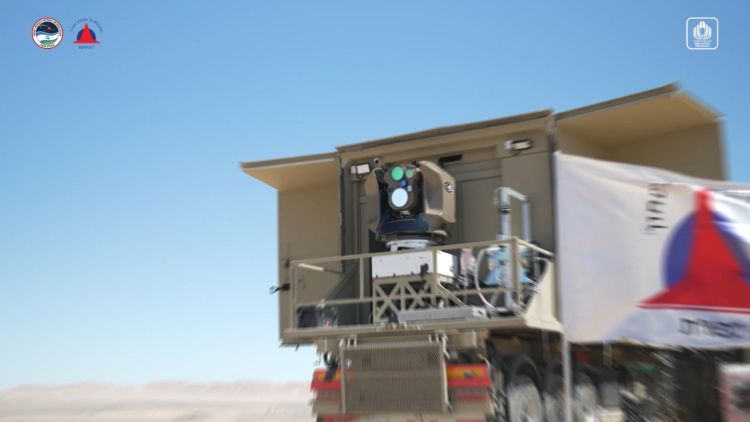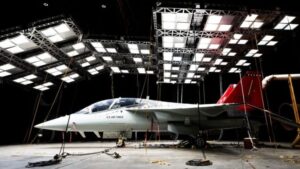Israel is doubling down on high-tech defense, earmarking $530 million to speed up the development of its groundbreaking laser air defense system, known as “Iron Beam.”
The announcement from Israel’s defense ministry on Monday, October 28, has drawn attention not only for its significant investment but also for the potential game-changer that this system could be on the battlefield.
Here’s what we know so far on the matter.
What Is Iron Beam?
So, what exactly is Iron Beam? Developed by Israel’s RAFAEL Advanced Defense Systems, it is a 100kW class High Energy Laser Weapon System (HELWS).
In simpler terms, it’s a highly advanced laser defense system designed to intercept and neutralize a range of aerial threats, from drones to incoming projectiles, within seconds.
Operating at the speed of light, Iron Beam has an unlimited “magazine” and comes with near-zero cost per interception—meaning once it’s operational, it could be as efficient as it is powerful.
Iron Beam isn’t entirely new; RAFAEL has been working on Directed Energy systems for over three decades, and Iron Beam is set to become the world’s first operational high-energy laser system in its class.
It can hit targets from hundreds of meters to several kilometers away, quickly neutralizing them with minimal risk of collateral damage. And thanks to RAFAEL’s years of expertise, Iron Beam is highly versatile, able to integrate with various platforms and complement Israel’s existing defense layers, like the Iron Dome.
Israel is doubling down on high-tech defense, earmarking $530 million to speed up the development of its groundbreaking laser air defense system, known as “Iron Beam.”
The announcement from Israel’s defense ministry on Monday, October 28, has drawn attention not only for its significant investment but also for the potential game-changer that this system could be on the battlefield.
Here’s what we know so far on the matter.
What Is Iron Beam?
So, what exactly is Iron Beam? Developed by Israel’s RAFAEL Advanced Defense Systems, it is a 100kW class High Energy Laser Weapon System (HELWS).
In simpler terms, it’s a highly advanced laser defense system designed to intercept and neutralize a range of aerial threats, from drones to incoming projectiles, within seconds.
Operating at the speed of light, Iron Beam has an unlimited “magazine” and comes with near-zero cost per interception—meaning once it’s operational, it could be as efficient as it is powerful.
Iron Beam isn’t entirely new; RAFAEL has been working on Directed Energy systems for over three decades, and Iron Beam is set to become the world’s first operational high-energy laser system in its class.
It can hit targets from hundreds of meters to several kilometers away, quickly neutralizing them with minimal risk of collateral damage. And thanks to RAFAEL’s years of expertise, Iron Beam is highly versatile, able to integrate with various platforms and complement Israel’s existing defense layers, like the Iron Dome.
From Concept to Operational Readiness
Israel’s defense experts, alongside Rafael, have been developing this laser technology for years.
Back in 2021, a significant test showed Iron Beam’s power in action—a video captured a laser system firing from a small aircraft, aiming at a drone, burning a hole right through it, and setting it ablaze. This successful test was a milestone, proving that the technology wasn’t just a futuristic concept but something close to reality.
Below is a video from RAFAEL taken during a live field test of the Iron Beam in March 2022.
With the new funding, Israel’s defense ministry hopes to push Iron Beam into operational service within the year.
The project is now a collaboration between RAFAEL and another defense firm, Elbit Systems, which recently received a $200 million contract from the ministry specifically for Iron Beam’s development. By teaming up, these two companies aim to make Iron Beam the latest addition to Israel’s impressive air defense arsenal.
Iron Beam’s Role in Israel’s Defense Strategy
The timing of Iron Beam’s development is no coincidence.
Israel is facing renewed threats from Hezbollah in Lebanon and ongoing conflicts with Hamas in Gaza.
Hezbollah has fired projectiles and launched drones into Israeli territory, and while Israel’s current defense systems, like the Iron Dome, are effective, they can’t intercept everything.
Gaps in coverage have led to civilian and military casualties, emphasizing the need for an additional layer of protection.
Iron Beam could be the answer to these challenges. By adding a laser-based system to its lineup, Israel gains a more efficient and cost-effective way to intercept incoming threats, especially those that are smaller, more mobile, or launched in high volumes.
Iron Dome, which has proven its worth time and again, is fantastic for handling traditional rockets and missiles, but Iron Beam offers something unique: a way to engage threats at the speed of light, with minimal cost, and without running out of ammunition.
A Multi-Layered Defense Against Modern Threats
Israel’s air defense approach is a multi-layered strategy. It’s built to handle everything from short-range rockets to long-range ballistic missiles, with systems like Iron Dome, David’s Sling, and Arrow missiles.
These systems work together to create a comprehensive shield against incoming threats. With the addition of Iron Beam, Israel will strengthen this shield, particularly in cases where high-volume or lower-altitude attacks are likely.
Iron Beam could also help Israel manage the rising costs of intercepting projectiles. The beauty of a laser system like Iron Beam is that it doesn’t require the physical ammunition of traditional missile interceptors. It can operate as long as it has power, intercepting threats with little additional cost per use.
This isn’t just a technical advantage; it’s a financial one, especially as Israel continues to manage the high costs of maintaining its defenses.
Iron Beam: The Future of Warfare?
The broader implication of Iron Beam is its potential to shift the way air defense is handled not only in Israel but globally.
Israel’s innovation in laser technology could inspire other countries to pursue similar systems.
In the long run, laser-based defenses like Iron Beam could reduce reliance on traditional missile defense systems and their costly supply chains.
Directed Energy weapons offer a new frontier in defense, where threats are managed at high speeds with pinpoint accuracy and, critically, with minimal impact on surrounding areas.
As we move forward, Iron Beam could also serve as a prototype for future laser-based defenses worldwide. RAFAEL, in partnership with Israel’s Defense Ministry, continues to lead in Directed Energy research, potentially making Israel a key player in high-energy laser technology.
A Strategic Investment for Israel’s Security
With an $8.7 billion military aid package from the US, a significant portion of which is designated for air defense, Israel has the backing it needs to continue its defense innovations.
Of this package, $5.2 billion has been reserved specifically for developing and enhancing air defense, including high-powered laser systems like Iron Beam.
The funding reinforces the importance of Israel’s defenses as it faces increased hostilities on multiple fronts.
As Israel moves closer to operationalizing Iron Beam, it isn’t just investing in technology; it’s doubling down on a strategy to maintain its security against ever-evolving threats.
Laser defense may sound like science fiction, but in Israel, it’s quickly becoming a reality.
With the development of Iron Beam, Israel is not only securing its borders but also pioneering new ways of protecting lives in today’s complex landscape.



